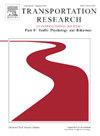Analysis of driver Lane-Changing behavior under the influence of truck platoons at highway Exits: A driving simulation study
IF 3.5
2区 工程技术
Q1 PSYCHOLOGY, APPLIED
Transportation Research Part F-Traffic Psychology and Behaviour
Pub Date : 2025-05-08
DOI:10.1016/j.trf.2025.04.029
引用次数: 0
Abstract
With the rise of truck platooning for improved fuel efficiency and road usage, new challenges have emerged for drivers at highway exits where truck platoons can create significant barriers, acting like moving walls that prevent safe lane changes for exiting vehicles due to their length and position. This study investigates driver lane-changing and off-ramp behaviors near highway exits under the influence of truck platoons. Using a driving simulation experiment, the impact of varying truck platoon gaps and different lateral distributions on driver decisions was analyzed. The CART algorithm, XGboost, and other predictive models for developing lane-changing decisions were analyzed and compared. Based on the interpretability and predictability of these models, further analysis was conducted on the degree of influence of variables on decision-making. Key findings indicate that larger platoon gaps increase merging rates and driver confidence in overtaking, while smaller gaps lead to more late lane changes and conservative behaviors. The speed difference between the vehicle and the truck platoon and the distance between the vehicle and the tail truck of the platoon have the greatest impact on the driver lane-changing decisions. Insights from this study can inform the design of truck platooning strategies and driver assistance systems, ultimately enhancing traffic efficiency and safety at highway exits.
高速公路出口卡车队列影响下驾驶员变道行为分析——驾驶仿真研究
为了提高燃油效率和道路利用率,卡车车队的兴起给高速公路出口的司机带来了新的挑战,卡车车队可能会制造明显的障碍,就像移动的墙一样,由于它们的长度和位置,阻碍了驶出车辆的安全变道。本文研究了在货车队列影响下,高速公路出口附近驾驶员变道和下匝道行为。通过驾驶仿真实验,分析了不同卡车排间距和不同横向分布对驾驶员决策的影响。分析和比较了CART算法、XGboost和其他用于制定变道决策的预测模型。基于这些模型的可解释性和可预测性,进一步分析变量对决策的影响程度。研究发现,较大的排距增加了合并率和驾驶人的超车信心,而较小的排距导致更多的晚变道和保守行为。车辆与车队的速度差以及车辆与车队尾车的距离对驾驶员变道决策的影响最大。这项研究的见解可以为卡车队列策略和驾驶员辅助系统的设计提供信息,最终提高高速公路出口的交通效率和安全性。
本文章由计算机程序翻译,如有差异,请以英文原文为准。
求助全文
约1分钟内获得全文
求助全文
来源期刊
CiteScore
7.60
自引率
14.60%
发文量
239
审稿时长
71 days
期刊介绍:
Transportation Research Part F: Traffic Psychology and Behaviour focuses on the behavioural and psychological aspects of traffic and transport. The aim of the journal is to enhance theory development, improve the quality of empirical studies and to stimulate the application of research findings in practice. TRF provides a focus and a means of communication for the considerable amount of research activities that are now being carried out in this field. The journal provides a forum for transportation researchers, psychologists, ergonomists, engineers and policy-makers with an interest in traffic and transport psychology.

 求助内容:
求助内容: 应助结果提醒方式:
应助结果提醒方式:


